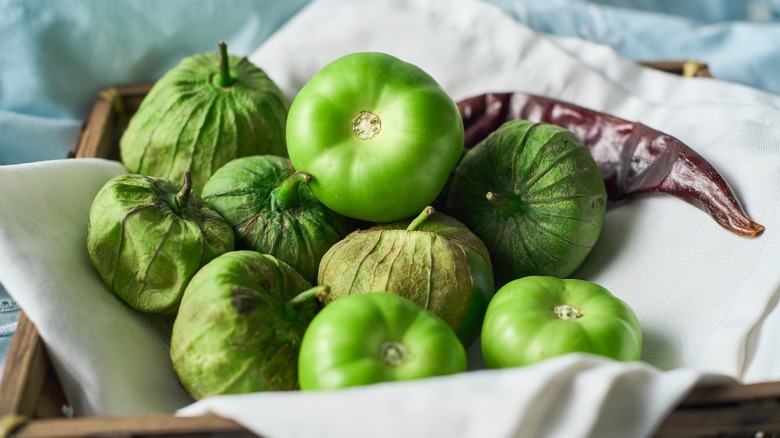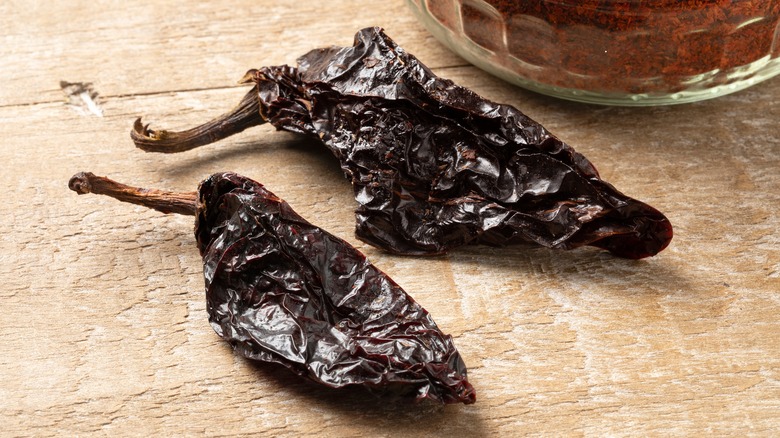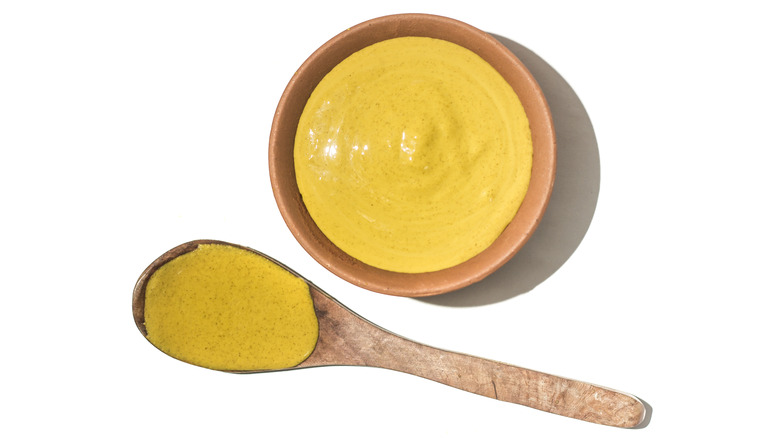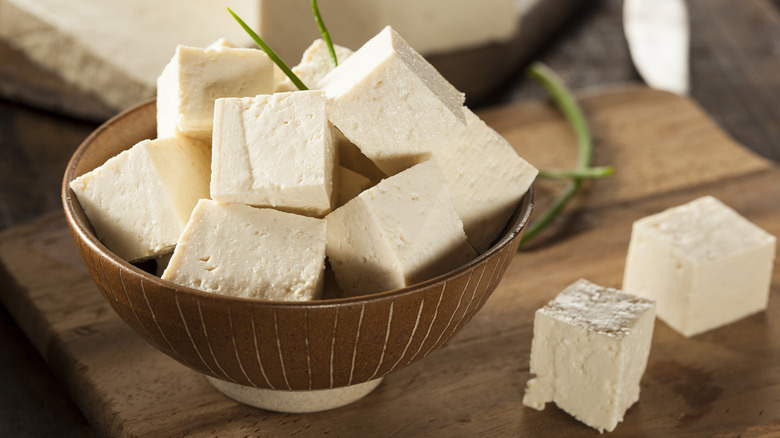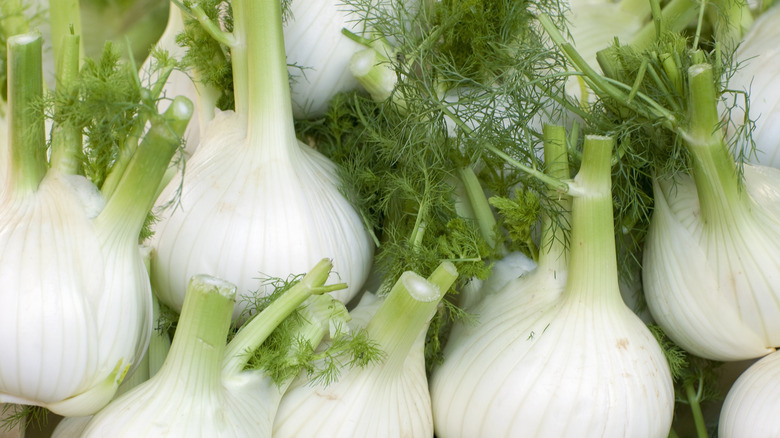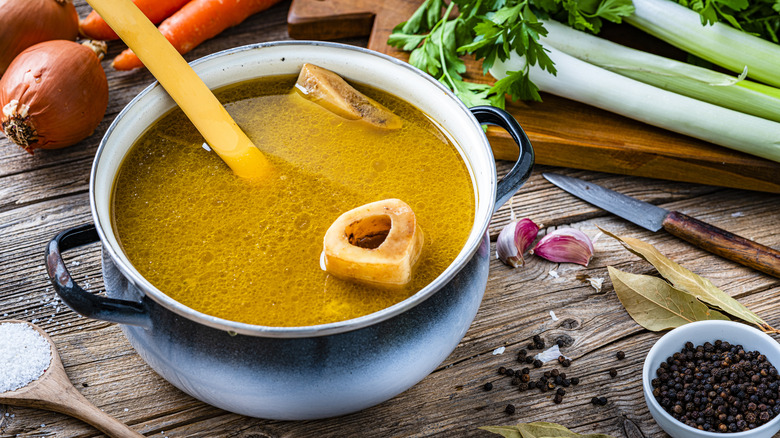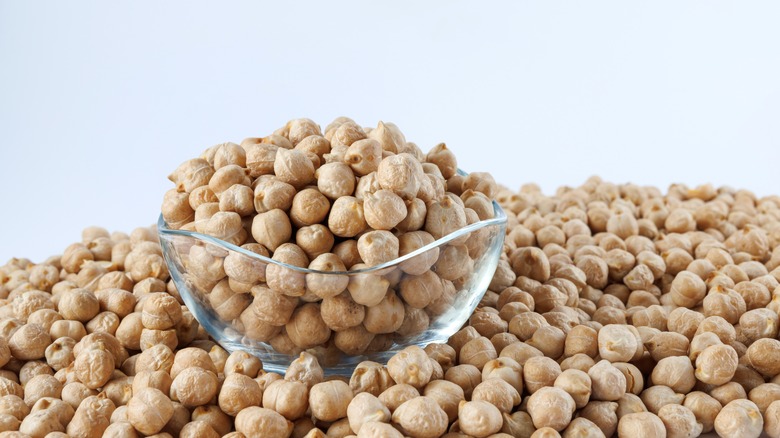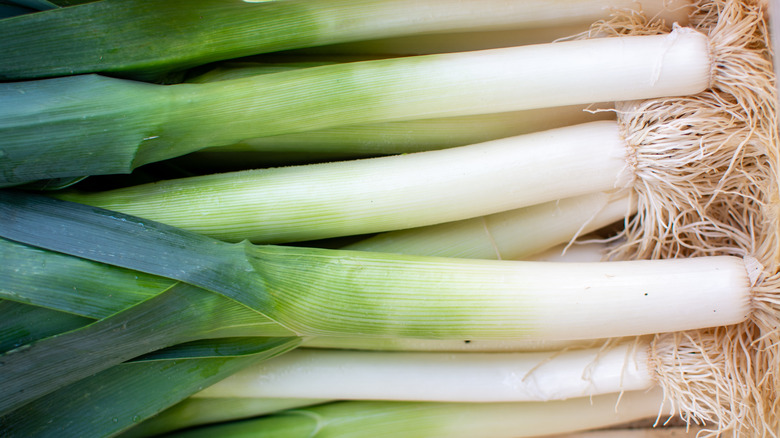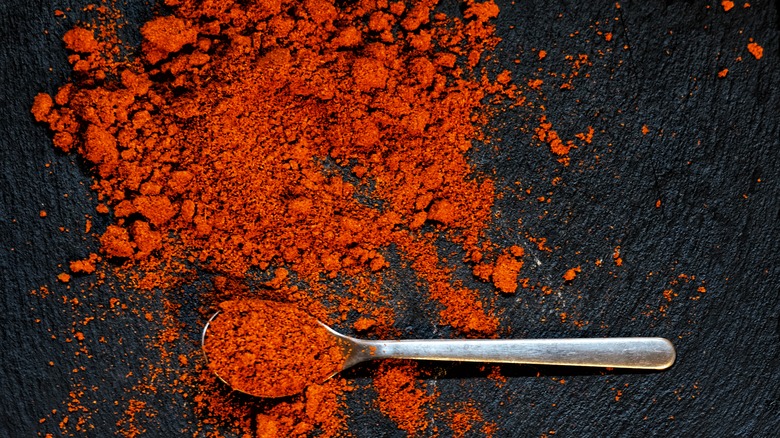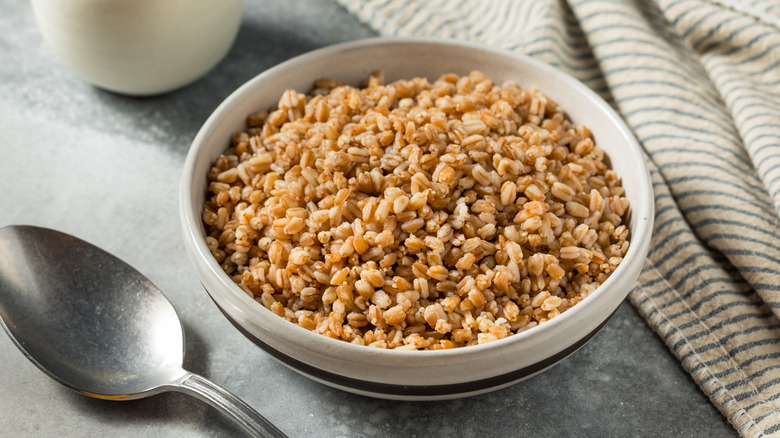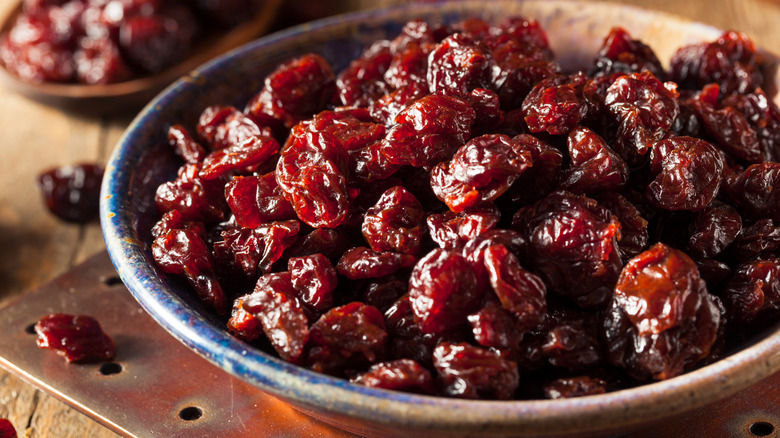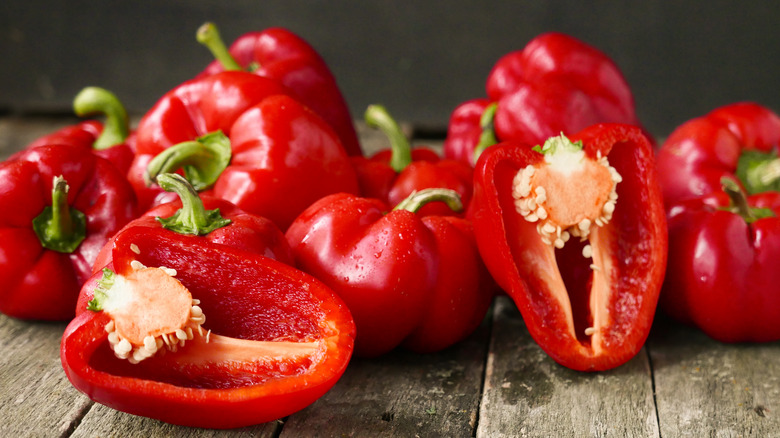Ingredient Swaps That Will Transform Your Chili
Chili is a dish that inspires endless creativity in the kitchen. At its core, the dish is a hearty blend of meat, peppers, beans, tomatoes, and spices. But within this framework lies an opportunity to explore new flavors and textures. "Enhancing the flavor of chili is a balancing act of salty, sweet, spicy, acidic, and umami," explains John Rice, executive chef of Wicked Weed Brewing. For those who love to experiment, there are countless ways to tweak these elements for a chili that's uniquely yours.
Of course, some ingredients are pretty non-negotiable, at least to certain chefs out there. "My one die-hard rule of thumb is to always use onions and garlic," says Chris Stewart, owner and executive chef at The Glass Onion. While not everyone feels the same as Stewart, these ingredients can indeed provide a deep, savory base that is hard to replace. Still, with or without them, there's plenty of room to play.
Whether you're looking to make your chili smokier, sweeter, or entirely meatless, a few strategic substitutions can take your recipe from ordinary to extraordinary. In this article, we'll explore some fresh and exciting chef-approved ingredient swaps that can truly transform your chili, so you can easily switch up your tried-and-true recipe from time to time.
Swap tomatoes for tomatillos
Tomatoes are often the go-to ingredient in chili, but for something with a bit more zest, consider using tomatillos instead. Tomatillos, often mistaken for green tomatoes, are small, round fruits encased in a papery husk. Hugely popular in Mexico, they have a slightly sour, citrusy flavor that can make your chili much more vibrant. "I like to use tomatillos for some southwestern-style chilis," John Rice notes. "They are tart and acidic and go great with leaner chilis like chicken or turkey."
Because of their tangy flavor, tomatillos can turn an average chili into something unique, providing a refreshing contrast to what many expect. Even better, they deliciously complement the smokiness of certain meats or the earthiness of cumin, adding layers of flavor that will make your chili stand out. If you're aiming for a chili that's both bright and flavorful, tomatillos might be the perfect ingredient to add.
Swap (some) stock for bourbon
For those looking to include something a little outside of the box in their chili, sometimes the trick is to turn to alcohol. Dafne Mejia, a private chef and runner-up on season 21 of "Hell's Kitchen," suggests replacing part of the stock you'd normally use in your chili with bourbon to "really give it a bold flavor and add smokiness ... that just elevates it."
Bourbon's unique flavor profile – rich with notes of caramel, vanilla, and oak — brings a depth that complements the heartiness of chili. When simmered, the alcohol evaporates, leaving behind a concentrated essence that highlights the savory elements of the dish. The subtle sweetness of bourbon can also balance out the heat from spices, making it a smart addition whether your chili leans toward the mild or the fiery side.
If you're using a slow cooker, adding bourbon early in the cooking process allows the flavors to meld and intensify over time. For an even more pronounced effect, try pairing bourbon with smoked ingredients like smoked bacon or paprika to further enhance the chili's smoky complexity.
Swap smoked meat for chipotle peppers
There's no shame in wanting your chili to have a smoky depth without the hassle of smoking meat. For this, chipotle peppers are the perfect solution. Dafne Mejia is a big fan of this ingredient, particularly for its versatility. "Chipotle in adobo sauce will give you that smoky flavor," she says. And there is no special preparation needed because, by definition, chipotle peppers are jalapeños that have been dried and smoked already. Adding them to your chili will give it a smoky heat that transforms the overall flavor with minimal effort.
If you're worried about the spiciness, you can easily tone it down by removing the seeds and veins, leaving just the flavorful flesh. Chipotle peppers can be a great addition to beef or pork chili, where their smokiness works well with the heartiness of the meat. For vegetarian chili, they add a depth that might otherwise be missing without the inclusion of smoked meats.
Swap vinegar for yellow mustard
When it comes to adding acidity to chili, many cooks instinctively reach for the vinegar in their cupboard. However, John Rice suggests an alternative that might surprise you: yellow mustard. Yellow mustard adds an interesting depth to traditional chili flavors with "bright acidity and flavor," he explains.
The tangy bite of yellow mustard not only enhances the overall acidity of the dish but also contributes to its thickness, creating a chili that's rich and velvety without the need for extra fats or starches. So, if you're looking to add a surprising twist to your next batch of chili, try swapping out your usual vinegar for a spoonful of yellow mustard. You might be surprised at how much this common condiment can make the dish shine.
Swap meat for tofu and mushrooms
For anyone wanting to replace the meat in chili, tofu offers an alternative that's both nutritious and satisfying. "Honestly, I love using tofu," Dafne Mejia says. "People forget that tofu, especially firm tofu, can really add a lot of protein to your food." To incorporate, Mejia advises grinding the tofu up or smashing it with your hands, and then adding portobello or oyster mushrooms. "Oyster mushrooms really give it that meaty taste," she says.
The combination of tofu and mushrooms creates a hearty, meat-like texture that works really well for a vegetarian or vegan chili. And tofu's ability to absorb flavors means it will take on the rich flavor profile of your chili overall, making it a seamless substitute for any kind of ground meat.
Swap meat for textured vegetable protein
If you're aiming for a vegan or vegetarian chili that still delivers the hearty feel of traditional chili, textured vegetable protein (TVP) is another excellent option. John Rice recommends this lesser-known ingredient, describing it as "a great vegetarian protein substitute that can be flavored with a marinade or spice blend to have the perfect chili flavor profile."
Made from soy flour and high in protein and fiber, TVP easily absorbs the flavors of whatever it's cooked with, so it's an ideal base for a deeply flavorful chili. It's also easy to find in organic markets and health food stores, making it a convenient swap for those who want to cut down on meat without losing any of the satisfying texture and taste for which chili is known and loved.
Swap oregano for fennel
Ready to break away from the usual flavor profile of chili? If so, fennel seed could be your new best friend. "Fennel seed is what I would use instead of oregano," Dafne Mejia says. "It adds more flavor, makes it a little bit different, and gives it a freshness it wouldn't otherwise have."
The one-of-a-kind taste of fennel seeds — combining what Chris Stewart calls a "savory sweetness" with a subtle anise flavor — introduces an extra layer of complexity, infusing your chili with a distinctive, refreshing twist. According to Stewart, it's a flavor you won't find in traditional chilis. He has also found that using fennel seed can give the dish just the "sweet bite" it needs because "a lot of chili is over-sweetened with too much sugar."
Swap store-bought broth for homemade bone stock
Swapping out store-bought broth or stock with homemade bone stock can add a real boost to the richness of your chili. "Using reduced bone stock adds a great texture, as the rendered gelatin that comes from simmering bones naturally thickens the stock," John Rice explains. The gelatin not only enhances the mouthfeel but also enriches the chili with a deeply savory flavor that store-bought stocks often lack.
A well-prepared bone stock is so robust that it could even stand in for tomatoes. "Instead of tomatoes, go for a really rich, concentrated stock to add in based on the protein — beef stock with beef, chicken stock with chicken, and so on," Chris Stewart suggests. This approach allows the natural flavors of the meat to shine while adding a luscious depth to your chili that's hard to achieve with traditional broth. Plus, the slow-cooking process extracts nutrients and minerals from the bones, making your chili not only tastier but also more nutritious.
Swap flour for saltine crackers
Dafne Mejia offers a simple yet unconventional solution to thickening your chili without relying on traditional methods: saltine crackers. "Making a chili thick, usually people will add flour or things like that," she explains. "Adding saltine crackers and smashing them into the sauce will add a little bit more viscosity to your chili, making it flavorful, salty, and delicious."
This unexpected swap works wonders, especially when you want a more creative thickening agent that also introduces a nuanced layer of flavor. As the saltines dissolve into the chili, they absorb excess liquid, and thus create a thicker, more cohesive texture. Beyond thickening, they also infuse the dish with a subtle, savory note that balances the flavors within the chili without overpowering them.
Swap cornstarch for corn stalks
Chris Stewart suggests avoiding store-bought flour or cornstarch as a thickening agent for your chili. "Trust me, you won't need them," he assures. But in place of those thickeners, you still have to use something to prevent it from becoming too watery. That's where corn stalks come in. John Rice recommends simmering them directly in the chili to extract the natural cornstarch left behind after removing the kernels. This method imparts a slight earthy flavor that complements the other ingredients.
In addition to thickening your chili, the corn stalks also infuse it with a gentle sweetness. As they simmer, the stalks release their natural sugars, adding complexity without overwhelming the dish. This technique not only serves a practical purpose — especially if you want the chili to be gluten-free — but also results in a more farm-to-table style flavor.
Swap brown sugar for sorghum syrup
To give your chili recipe a twist, consider swapping out brown sugar for sorghum syrup. John Rice swears by this substitution, especially in recipes that call for balancing sweetness with acidity. "Sorghum adds a deep, slightly bitter characteristic, enhancing flavor while also providing a balance of sweetness to contrast some of the more acidic ingredients like vinegar, Worcestershire, and tomato," Rice says.
Sorghum syrup, a staple in Southern cooking, brings a complex flavor profile that pairs beautifully with the robust, hearty nature of chili. Its slight bitterness offsets the sweetness, while its molasses-like consistency adds a rich depth that you simply can't get from regular sugar. This swap is particularly well-suited for those who enjoy chili with a little extra sweetness.
Swap beans for chickpeas
Using chickpeas — also known as garbanzo beans — instead of the traditional chili legumes, like black, pinto, or kidney beans, is a delicious way to introduce new textures and flavors to your chili. John Rice champions this ingredient swap, emphasizing the different properties of chickpeas that can enhance this dish. Thanks to their firmer consistency, "chickpeas give chili a great crunchy texture," Rice says. "They also release a starch that acts as a thickener." This means you can achieve a heartier chili without relying on additional thickeners.
These versatile legumes have a mild, nutty flavor that pairs seamlessly with the smoky and spicy notes typical of chili. Their texture and flavor offer a refreshing twist for those looking to experiment outside of the traditional chili recipes.
Swap salt for tamari
Switch up the flavor of your chili by incorporating tamari, a Japanese version of soy sauce that is typically gluten-free, as it is made from fermented soybeans. Unlike using regular salt, tamari not only adds salinity but also introduces a more profound savoriness that can boost the overall taste of the dish.
John Rice praises tamari for its "high glutamic acid content, giving the chili an umami factor." This ingredient is especially useful for those with certain dietary restrictions, as it provides the depth of flavor that soy sauce would typically offer, but without the gluten or high sodium content. Plus, tamari tends to have a gentler flavor profile than traditional soy sauce, allowing you to enhance your chili without overpowering its other ingredients.
Swap onions for leeks
According to John Rice, if you're going for a subtly surprising flavor in your chili, consider substituting traditional onions with "other aromatic vegetables, like leeks." Leeks offer a sweeter, milder taste compared to the more pungent bite of regular onions, which can make your chili a bit more elegant. This difference is thanks to leeks' softer sulfur compounds, which give them a gentler flavor.
On top of that, leeks cook down beautifully, integrating seamlessly into the chili and allowing their sweetness to meld with the other flavors. They also bring a bit of earthiness that pairs well with lots of spices and herbs. Caramelizing the leeks before adding them to the chili will deepen their flavor even further, introducing a nutty taste to the mix.
Swap store-bought chili powder for homemade chili powder
An easy way to truly elevate your chili is to replace store-bought chili powder with your own homemade version. Dafne Mejia emphasizes the benefits of homemade chili powder, noting that pre-made options can sometimes result in unwanted flavors in your chili. "I feel like people overuse chili powder in recipes, and then you kind of get that chalky taste to chili," she explains. To create your own blend, Mejia recommends combining smoked paprika, cayenne pepper, onion powder, garlic powder, and chicken bouillon for a robust base. "I love Spanish paprika. It adds a zing to it. Also, using saffron will change the color and add more flavor," she says.
Chris Stewart agrees, highlighting that grinding whole spices at home enhances the depth and vibrancy of flavors. "Grind them up yourself and thank me later," he recommends, emphasizing that although it takes a bit more time, the result is well worth it.
Swap beans for farro
A lot of people avoid legumes because it makes them bloated. But how do you avoid them in chili, when beans are known to be a staple ingredient? An alternative would be using a healthy grain like farro, according to Dafne Mejia. "You need that texture, that firmness" to replace the beans. Farro adds the texture you're looking for, Mejia says.
Chris Stewart also supports this swap, noting, "If you wanted something that would still lend itself to the heartiness of kidney beans, an alternative would be farro." It has a chewy and heavier consistency, which can mimic the satisfying texture of beans without causing the same digestive issues. It also has nutty undertones, which blend well with the more standard chili flavors.
Swap chocolate for dried cherries
Lots of people who like a sweeter chili immediately think of chocolate as a go-to addition. However, that's not the only creative way to satisfy your sweet tooth when it comes to chili. Instead, Dafne Mejia suggests adding dried cherries as a tasty alternative. "Dried cherries bring a lovely sweetness and a burst of flavor without completely changing the profile of your chili," she says.
Dried cherries are both tangy and sweet, offering a fruity note that goes very well with both the spicy and savory elements of chili. Plus, their chewy texture adds a fun contrast to the other ingredients. Nutritionally, dried cherries are packed with antioxidants and can boost your chili's health benefits, making this swap not only delicious but good for you, too.
Swap tomatoes for red bell peppers
If you need to avoid tomatoes, because of acid reflux or any other reason, don't despair — chili can still be on your radar. Dafne Mejia recommends red bell peppers as being a good alternative when tomatoes are off-limits. First of all, red bell peppers bring a naturally sweet and mild flavor to your chili, which helps to keep the dish flavorful without the acidity of tomatoes. Their vibrant color also adds a cheerful pop to your bowl. Plus, red bell peppers are packed with vitamins A and C, giving your chili a healthy boost to boot.
Roasting your red bell peppers before adding them to the chili can further bring out their sweetness while adding a charred, smoky flavor. The end result is an even more satisfying and delicious chili to delight your palate.

